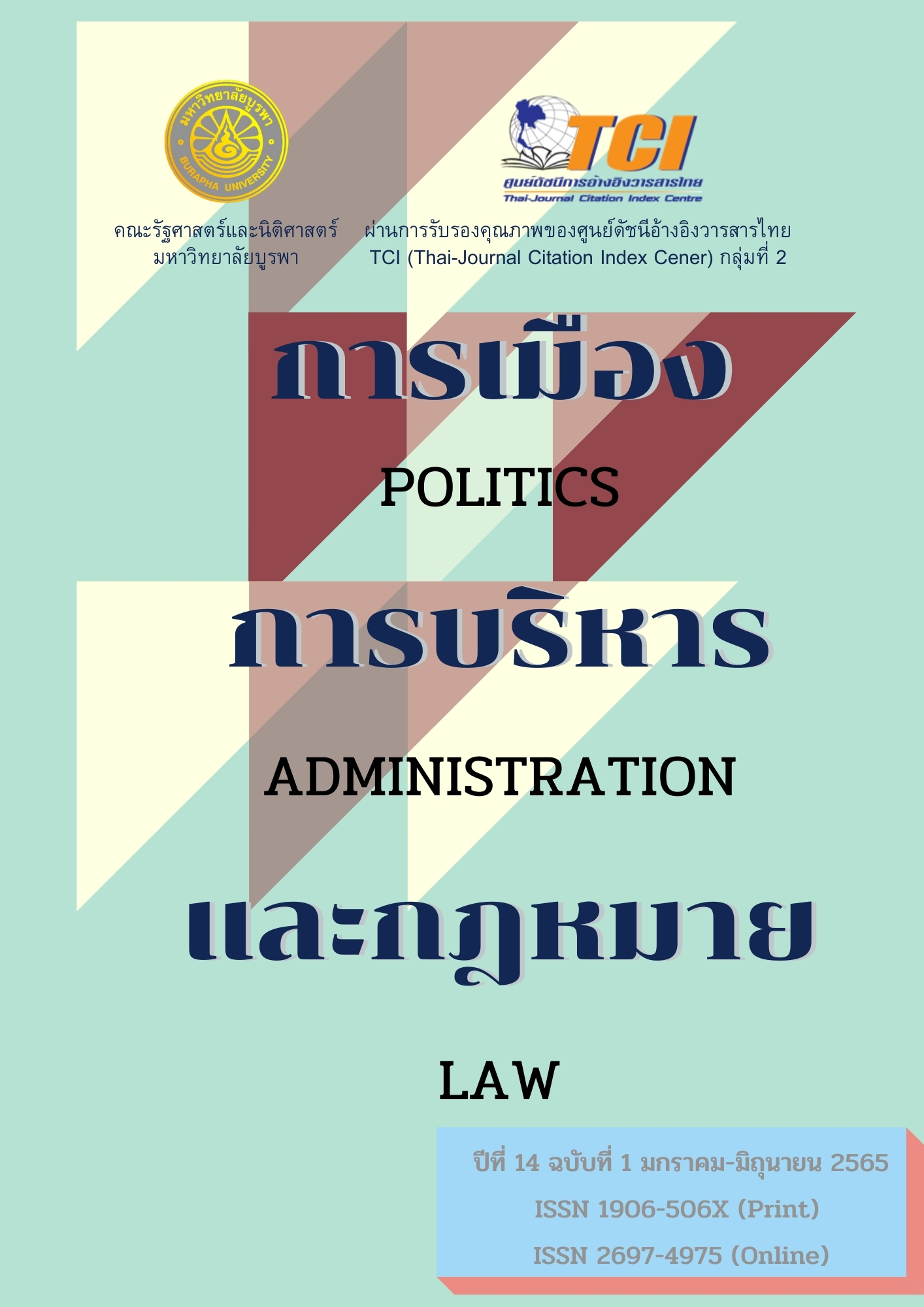ความทุ่มเทให้กับงานของพนักงานรัฐวิสาหกิจด้านพลังงานไฟฟ้าของไทย
คำสำคัญ:
ความทุ่มเทให้กับงาน, รัฐวิสาหกิจบทคัดย่อ
การวิจัยนี้มีวัตถุประสงค์ คือ 1) เพื่อศึกษาระดับความทุ่มเทให้กับงานของพนักงานรัฐวิสาหกิจด้านพลังงานไฟฟ้าของไทย 2) เพื่อเปรียบเทียบความแตกต่างของความทุ่มเทให้กับงานของพนักงานรัฐวิสาหกิจด้านพลังงานไฟฟ้าของไทย ประกอบด้วย การไฟฟ้าฝ่ายผลิต การไฟฟ้านครหลวง และการไฟฟ้าส่วนภูมิภาค 3) เพื่อศึกษาปัจจัยที่มีอิทธิพลต่อความทุ่มเทให้กับงานของพนักงานรัฐวิสาหกิจด้านพลังงานไฟฟ้าของไทย โดยใช้แนวทางการวิจัยเชิงปริมาณ ตัวอย่างการวิจัย คือ พนักงานของรัฐวิสาหกิจไทยด้านพลังงานไฟฟ้าทั้ง 3 แห่ง จำนวน 398 คน เครื่องมือที่ใช้ในการศึกษา คือ แบบสอบถาม ใช้การตรวจสอบคุณภาพของเครื่องมือโดยการวัดความเชื่อถือได้ด้วยการทดสอบค่าสัมประสิทธิ์แอลฟาครอนบาคและ การวัดความแม่นตรงด้วยวิธีวิเคราะห์องค์ประกอบ สถิติที่ใช้ในการวิเคราะห์ข้อมูลทั่วไป ได้แก่ ความถี่ ร้อยละ ค่าเฉลี่ย ส่วนเบี่ยงเบนมาตรฐานและการทดสอบสมมติฐานด้วย Anova และ Multiple Regression ผลการวิจัย พบว่า ความทุ่มเทให้กับงานของพนักงานรัฐวิสาหกิจด้านพลังงานไฟฟ้าของไทยในภาพรวมอยู่ในระดับทุ่มเทมาก เมื่อพิจารณาเป็นรายด้านพบว่าการอุทิศตนเพื่อประโยชน์ขององค์การมีคะแนนเฉลี่ยสูงที่สุด รองลงมาคือ ด้านความคงไว้ซึ่งความเป็นสมาชิกขององค์การ ซึ่งหากเปรียบเทียบความแตกต่างของความทุ่มเทให้กับงาน พบว่า พนักงานของหน่วยงานทั้ง 3 แห่งมีความทุ่มเทให้กับงานที่แตกต่างกันอย่างมีนัยสำคัญทางสถิติที่ระดับ 0.05 โดยพนักงานของการไฟฟ้าฝ่ายผลิตมีความทุ่มเทให้กับงานมากกว่าพนักงานของการไฟฟ้าส่วนภูมิภาคและการไฟฟ้านครหลวง ทั้งนี้จากการศึกษาปัจจัยที่มีอิทธิพลต่อความทุ่มเทให้กับงานของพนักงานรัฐวิสาหกิจทั้ง 3 แห่ง และพบว่าปัจจัยด้านคุณภาพชีวิตในการทำงาน และปัจจัยด้านภาวะผู้นำการเปลี่ยนแปลง มีอิทธิพลต่อความทุ่มเทให้กับงานของพนักงาน ส่วนปัจจัยด้านทัศนคติต่อการทำงานไม่มีอิทธิพลต่อความทุ่มเทให้กับงานของพนักงานรัฐวิสาหกิจด้านพลังงานไฟฟ้าของไทย อย่างมีนัยสำคัญทางสถิติที่ระดับ 0.05
เอกสารอ้างอิง
กณิกนันต์ แสงมหาชัย. (2558). ความทุ่มเทให้กับงานกับผลการปฏิบัติงาน: ข้อเสนอกรอบทฤษฎีเกี่ยวกับ การบริหารทรัพยากรมนุษย์. ดุษฎีนิพนธ์สาขารัฐประศาสนศาสตร์, คณะรัฐศาสตร์, มหาวิทยาลัยรามคำแหง.
Allport, G. W. (1976). Attitudes. In Handbook of social psychology. Edited by C. Murchison, Worcester, MA: Clark Univ. Press.
Arthur, M. B., Khapova, S. N., & Wilderom, C. P. M. (2005). Career success in a boundaryless career world. Journal of Organizational Behavior, 26(2), 177-202.
Balaji, R. (2013). A study on quality of work life among employees. International Journal of Innovative Research in Science, Engineering and Technology, 2(2), 470-473.
Baron, R. A. (1986). Behavior in Organization. Boston: Allyn and Bacon.
Bass, B. M., & Avolio, B. J. (1994). Improving organization effectiveness through transformation Leadership. Thousand Oaks: Sage.
Blessing White (2008). The State of Employee engagement. NJ: Blessing white.
Brewer, A. M. & Lock, P. (1995). Managerial strategy and nursing commitment in Australian Hospitals, Journal of Advance Nursing, 21(4), 789-799
Carlson, H. C. (1980). A model of quality of work life as a developmental process. In W. W. Burke & L. D. Goodstein (eds.), Trends and Issues in OD.: Current Theory and Practice. San Diego: University Associate.
Crabtree, S. (2006). Getting Personal in the Workplace Are negative relationships squelching productivity in your company. The Gallup Management Journal, 10, 1-4.
Daft, R. L. (2011). Leadership (5th ed.). South-Western Cengage Learning.
Elizur, D. (1990). Quality circles and quality of work life. International Journal of Manpower, 11, 3-7.
Fishbein, M. (1967). Attitude Theory and Measurement. New York Jonn Wiley
Gallup. (2013). State of the global workplace. Washington DC: The Gallup Headquarters.
Gallup. (2017). State of The Global Workplace. New York: Gallup press.
Greenberg, J., & Baron, R. A. (1997). Behavior in organizational (6 th ed.). New Jersey: Prentice-Hall.
Greenberg, J. (2004). Increasing employee retention through employee engagement. Retrieved September 7, 2021, from http://ezinearticle.com/?Increasing-Employee-Though-Employee Engagement & id =10575
Harter, J. K., Schmidt, F. L., & Hayes, T. L. (2002). Business-unit-level relationship between employee satisfaction, employee engagement, and business outcomes: A meta-analysis. Journal of Applied Psychology, 87(2), 268-270.
Hewitt, A. (2003). What is Employee Engagement?. Retrieved July 26, 2020, from http://was2.hewitt.com/bestemployers/turkey/pages/emp_eng.htm
Judge, T. A., & Mueller, J. D. K. (2012). Job Attitudes. The Annual Review of Psychology, 63, 341-367.
Kahn, W. A. (1990). Psychological conditions of personal engagement and disengagement at work. Academy of Management Journal, 33, 692-724.
Kiernan, W. E., & Knutson, K. (1990). Quality of work life. Washington, DC: American Association of Mental Retardation.
Koontz, S. W., & Schimmel, P. (1982). A covalent adduct between the uracil ring and the active site of an aminoacyltRNAsynthetase. Nature, 298(5870), 136-140.
Mann, A. & Harter, J. (2016). The Worldwide Employee Engagement Crisis. Retrieved July 26, 2020, from https://www.gallup.com/workplace/236495/worldwide-employee-engagement-crisis.aspx
Maslach, C., Schaufeli, W. B., & Leiter, M. P. (2001). Job burnout. Annual Review of Psychology, 52, 397-422.
Meyer, J., & Allen, N. (1997). Commitment in the workplace. Thousand Oaks, CA: Sage.
Nadler, L., & Lawler, E. E. (1983). Quality of work life: Perceptions and direction. Organizational Dynamics, 11(3), 20-30.
Newstrom, J. W., & Davis, K. (2002). Human Behavior at Work: Organizational Behavior (8th ed). New York: McGraw-Hill.
Paul, M. M., (1997). Psychology Applied to Work An Introduction to Industrial and Organization Psychology (5th edition). California: Brooks/Cole.
Perrin, T. (2003). Working today: Understanding what drives employee engagement, the 2003 Towers Perrin talent report. Vancouver, Canada: Author.
Razali, M. Z. (2004). Perception of professional engineers toward quality of work life and organizational commitment, a case study. Gadjah Mada International Journal of Business, 6, 323-334.
Rothbard, N. P. (2001). Enriching or Depleting? The Dynamics of Engagement in Work and Family Roles. Administrative Science Quarterly, 46, 655-684.
Rothbard, N. P. (2001). Enriching or depleting?: The dynamics of engagement in work and family roles. Administrative Science Quarterly, 46(4), 655-684.
Rothbard, N. P. & Patil, S. V. (2011). Being There: Work Engagement and Positive Organizational Scholarship. In G. M. Spreitzer & K. S. Cameron (Eds.), The Oxford Handbook of Positive Organizational Scholarship. New York: Oxford University Press.
Rich, B. L. (2006). Job engagement: Construct validation and relationships with job satisfaction, job involvement, and intrinsic motivation. Unpublished doctoral dissertation, University of Florida, Gainesville, FL.
Secord, F. & Backman, C. W. (1967). Social Psychology. New York: McGraw-Hill Book Co.
Saks, A. M. (2006). Antecedents and consequences of employee engagement. Journal of Managerial Psychology, 21, 600-619.
Surienty, L., Ramayah, T., Lo, M. C. & Tarmizi A. N. (2014). Quality of work life and turnover intention: A Partial Least Square (PLS) approach. Social Indicators Research, 119, 405-420.
Vance, R. J. (2006). Employee engagement and commitment; A guide to understanding, measuring and increasing engagement in your organization. VA: SHRM Foundation.
Walton, R. E. (1974). Improving the Quality of Work Life. Harvard Business Review, 12-16.
Yukl, G. (1994). Leadership in Organizations (4th ed.). Englewood Cliffs, NJ: Prentices Hall.
ดาวน์โหลด
เผยแพร่แล้ว
ฉบับ
ประเภทบทความ
สัญญาอนุญาต

อนุญาตภายใต้เงื่อนไข Creative Commons Attribution-NonCommercial-NoDerivatives 4.0 International License.






